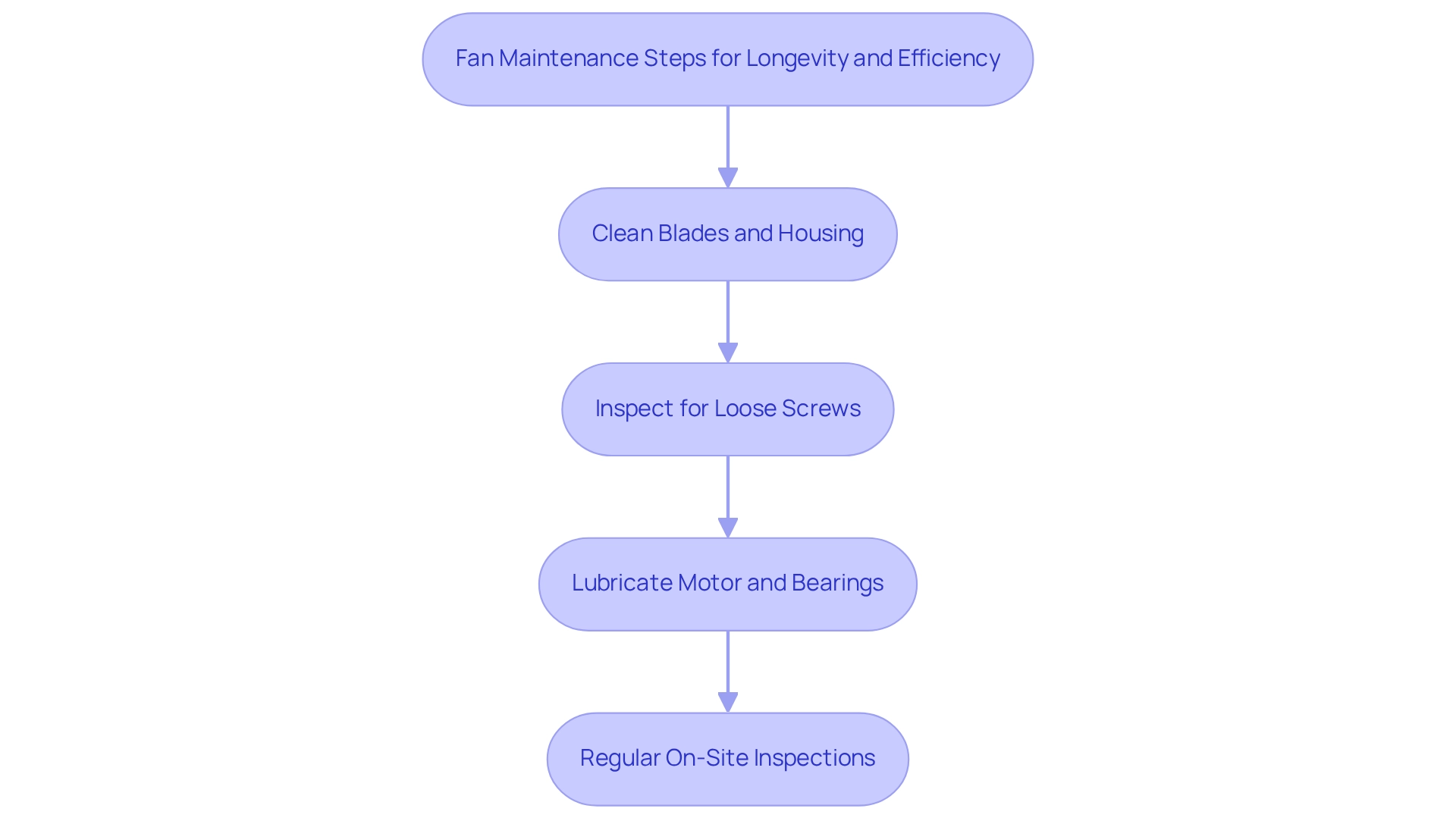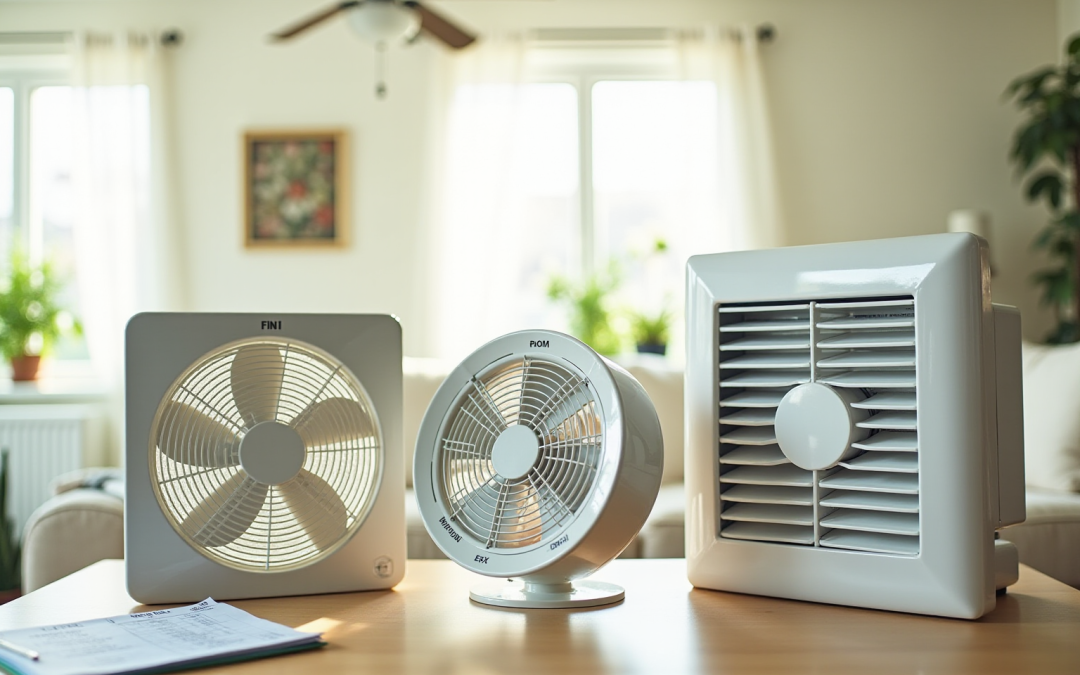Overview
This article delves into optimizing fan choices, offering essential tips on power usage, efficiency, and maintenance to enhance performance and minimize energy consumption. It underscores the critical importance of selecting the appropriate fan type, size, and energy-efficient models. Regular maintenance practices are highlighted as vital for achieving optimal airflow and longevity. By adhering to these guidelines, readers can effectively contribute to both cost savings and sustainability.
Introduction
In an age where energy efficiency is paramount, understanding the intricacies of fan selection and maintenance is crucial for achieving significant savings and enhanced comfort. Evaluating the power usage of various fan types, alongside selecting the optimal size and speed settings, plays a vital role in maximizing airflow and minimizing energy consumption.
This article explores the essential factors for choosing the right fan, underscoring the importance of ENERGY STAR certification and proper maintenance practices. By prioritizing efficiency and performance, individuals can foster a more sustainable environment while reaping the benefits of effective cooling solutions.
Evaluate Power Usage of Different Fan Types
Various types of ventilators—including ceiling units, box models, and exhaust systems—exhibit differing power requirements. For instance, a standard ceiling unit typically operates within a range of 50 to 75 watts, whereas box devices may consume between 80 to 100 watts. Understanding these distinctions is crucial for selecting a fan that meets your cooling needs without incurring excessive power consumption.
Gagner-Toomey Associates offers a comprehensive selection of DC input Tube Axial ventilators and Centrifugal Blowers, meticulously optimized for performance and efficiency, which can significantly enhance energy savings. Additionally, consider the performance rating of the devices; ENERGY STAR certified units can achieve efficiency levels up to 60% greater than traditional models. This assessment not only aids in lowering electricity bills but also contributes to a more sustainable environment, particularly when employing advanced cooling solutions from Gagner-Toomey Associates.
Consider Fan Size for Optimal Airflow
Selecting the appropriate size of a small fan is crucial for enhancing airflow performance in any area. For example, a small fan with a blade span of 52 inches is well-suited for rooms up to 400 square feet, whereas a 36-inch small fan is typically adequate for smaller spaces. Rooms exceeding 225 square feet require a fan with a CFM rating of 3,000 or higher to ensure effective air circulation.
Larger units are designed to shift more air at reduced speeds, resulting in quieter operation and improved efficiency. To optimize airflow, accurately measuring your room dimensions and consulting manufacturer guidelines is essential. This method not only prevents issues like stagnant air but also minimizes noise, as highlighted in a case study discussing noise problems related to improperly sized ceiling fixtures.
Regular maintenance is vital for keeping the fan operating efficiently over time. As Jim Pearson, an industry expert, asserts, “It’s important to calculate the size of a small fan that can provide enough airflow for the room to avoid issues such as stagnant air or uneven cooling.”
By selecting the appropriate fan size, you can ensure efficient air circulation and resource savings, thereby enhancing the comfort and effectiveness of your environment.
Select Appropriate Speed Settings for Your Needs
Small fans are typically equipped with various flow settings, enabling users to tailor airflow to their specific requirements. For example, utilizing a reduced setting during cooler evenings can conserve energy while still delivering sufficient airflow. Conversely, higher velocities may be essential during peak heat hours. Understanding the intricate relationship between fan rotation and power consumption is vital; a mere 10% decrease in rotation can lead to a substantial reduction in power usage, as power consumption varies with the cube of the rotation. This principle underscores the importance of adjusting the operational rates of a small fan based on both temperature and occupancy.
Practical applications exemplify the benefits of employing a small fan in this manner. The implementation of variable velocity motors in industrial fans allows users to modify fan speeds according to specific needs, significantly reducing power consumption during low-demand periods. This not only diminishes utility expenses but also prolongs the equipment’s lifespan by lessening wear and tear, enhancing control over airflow rates, and contributing to a quieter work environment. Furthermore, these devices are engineered for exceptional performance, which is crucial when selecting appropriate fan velocity settings. By strategically selecting small fan speed options, users can optimize savings and elevate overall system efficiency. Additionally, the Haiku L ceiling fan offers a lifespan exceeding 50,000 hours, emphasizing the significance of longevity and reliability in fan performance.
Choose Energy-Efficient Fan Models
When selecting ventilators, it is essential to prioritize models that are ENERGY STAR certified. These devices are engineered to consume significantly less power while delivering performance comparable to conventional models. For instance, efficient ceiling devices can reduce power consumption by as much as 75% compared to traditional alternatives.
Furthermore, devices equipped with DC motors offer enhanced performance and quieter operation than their AC counterparts. By investing in energy-efficient cooling devices, you not only lower your utility expenses but also make a meaningful contribution to fostering a sustainable future.
As Courtney Lindwall emphasizes, “Here’s how to save on electric vehicles, solar panels, heat pumps, and more through tax credits and rebates,” underscoring the broader context of power conservation. A prime example is the WhisperFit® DC Fan, which simplifies installation while meeting ENERGY STAR certification standards, illustrating the tangible benefits of opting for energy-efficient solutions.
Additionally, utilizing ceiling circulators allows for adjusting the thermostat to a higher setting, further reducing energy costs.
Maintain Your Fan for Longevity and Efficiency
Regular maintenance is essential for ensuring your fan operates at optimal performance. To start, routinely clean the blades and housing to eliminate dust and debris, which can significantly impair performance. A simple wipe with a damp cloth every few weeks can yield noticeable improvements and should be integral to a broader maintenance strategy that considers the specific requirements of both centrifugal and axial systems. Furthermore, inspect for loose screws and tighten them as necessary to prevent wobbling, which can lead to further mechanical issues.
Lubricating the motor and bearings according to the manufacturer’s guidelines is another vital step that enhances performance and extends the fan’s lifespan. Statistics indicate that proper upkeep can lead to a significant enhancement in performance, particularly for centrifugal models, which validate their higher expense through long-term durability and effectiveness in high-resistance systems. Regular maintenance practices, such as cleaning and lubrication, directly contribute to these benefits by ensuring optimal operation.
Real-world examples illustrate that regular maintenance not only prolongs the life of fans but also optimizes their operational efficiency. For instance, tailored maintenance solutions provided by FBG Servicing focus on minimizing disruptions and maximizing uptime through on-site inspections and repairs, which align with the cleaning and lubrication tips discussed. By dedicating a little time to maintenance, you can ensure your fan remains a reliable component in your electronic systems for years to come.

Conclusion
Understanding the nuances of fan selection and maintenance is crucial for achieving optimal energy efficiency and comfort in any environment. Evaluating the power usage of various fan types—ceiling fans, box fans, and exhaust fans—enables individuals to make informed decisions that not only address their cooling needs but also contribute to substantial energy savings. Selecting the appropriate fan size ensures effective airflow, while adjusting speed settings according to specific requirements can further enhance efficiency.
Prioritizing energy-efficient models, especially those with ENERGY STAR certification, is vital for minimizing energy consumption. These fans are engineered to deliver high performance while consuming less power, thereby fostering a sustainable future. Regular maintenance practices, including cleaning and lubrication, are essential for extending the lifespan of fans and optimizing their operational efficiency.
Ultimately, the combination of thoughtful fan selection, strategic use of settings, and diligent maintenance can create a more comfortable living or working space while significantly reducing energy costs. Embracing these practices not only benefits individual households but also contributes to a more sustainable environment for all.
Frequently Asked Questions
What are the different types of ventilators and their power requirements?
Various types of ventilators include ceiling units, box models, and exhaust systems. A standard ceiling unit typically operates within a range of 50 to 75 watts, while box devices may consume between 80 to 100 watts.
Why is it important to understand the power consumption of ventilators?
Understanding the power consumption distinctions is crucial for selecting a fan that meets your cooling needs without incurring excessive power consumption.
What options does Gagner-Toomey Associates offer for ventilators?
Gagner-Toomey Associates offers a comprehensive selection of DC input Tube Axial ventilators and Centrifugal Blowers that are optimized for performance and efficiency, significantly enhancing energy savings.
How can ENERGY STAR certified units benefit users?
ENERGY STAR certified units can achieve efficiency levels up to 60% greater than traditional models, helping to lower electricity bills and contribute to a more sustainable environment.
What factors should be considered when selecting the size of a small fan?
The size of a small fan should be based on the room dimensions; for example, a 52-inch fan is suitable for rooms up to 400 square feet, while a 36-inch fan is adequate for smaller spaces. Rooms exceeding 225 square feet require a fan with a CFM rating of 3,000 or higher for effective air circulation.
What are the advantages of larger fan units?
Larger fan units are designed to shift more air at reduced speeds, resulting in quieter operation and improved efficiency.
Why is regular maintenance important for fans?
Regular maintenance is vital for keeping the fan operating efficiently over time, preventing issues such as stagnant air or uneven cooling.
What should be done to ensure proper airflow in a room?
To optimize airflow, accurately measuring room dimensions and consulting manufacturer guidelines is essential. This helps prevent issues like stagnant air and minimizes noise.

